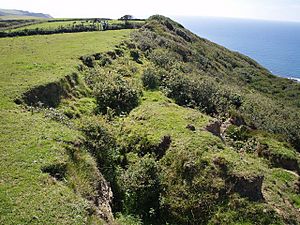Dizzard facts for kids
Quick facts for kids Dizzard |
|
|---|---|
| Location | Cornwall, UK |
| Coordinates | 50°45′N 4°37′W / 50.75°N 4.61°W |
| Geology | Coastal cliff, |
Dizzard (Cornish: Dyserth, meaning very steep) is a special area in Cornwall, UK. Its name comes from the Cornish language. It's home to five farms and a unique forest called Dizzard Wood. This forest is famous worldwide for its amazing collection of tiny plant-like organisms called lichens. You'll find Dizzard Point right on the coast.
Contents
Exploring Dizzard's Location
Dizzard is located in a beautiful part of Cornwall. To the north, it faces the huge Atlantic Ocean. To the west, you'll find the valley and cove of Crackington Haven. On the east side are the woods and valley of Millook.
Farms in Dizzard
There are five farms in the Dizzard area. Some of them might not be working farms anymore. Their names are Dizzard Farm, East Dizzard, Higher Dizzard, Old Dizzard, and West Dizzard.
Special Protected Areas
The Dizzard cliffs are part of several important protected areas. They are included in the Widemouth to Crackington Geological Conservation Review site. This means the rocks and landforms here are very important for science. The area is also part of the Boscastle to Widemouth SSSI. This protects its special wildlife and habitats. Dizzard is also within the Area of Outstanding Natural Beauty (AONB). This helps keep its natural beauty safe. It's also part of the Heritage Coast, which protects its special coastal scenery.
How to Get to Dizzard
The main road, called the Atlantic Highway, is about two miles to the east. A smaller road from Wainhouse Corner to Millook goes right through Dizzard. This smaller road is also part of National Cycle Route 3, which is great for bikes. The famous South West Coast Path also passes through Dizzard. This walking path follows the entire coast of south-west England. It goes along the top of the cliffs, giving amazing views of the Dizzard Wood below.
Wildlife and Nature at Dizzard
Dizzard is home to a very special forest. This forest grows on a huge landslip, which is where a large section of land has slid down from the top of the cliff. The cliff is about 400 feet high! The trees here are quite short, from 1 to 8 metres tall. This is because strong, salty winds from the ocean prune them naturally.
The Unique Dizzard Wood
The main type of tree in Dizzard Wood is the sessile oak (Quercus petraea). You can also find pedunculate oak (Q. robur), birch (Betula species), and rowan (Sorbus aucuparia). A few wild-service trees (Sorbus torminalis) also grow here. Many of these trees are covered in lichens and moss, making them look very old and magical.
Plants of Dizzard
Scientists have found 131 different types of lichen in Dizzard Wood. Some of these lichens are very rare and only grow in a few places in north Cornwall and Devon. Over one hundred different flowering plants have also been found here. These include pretty bluebells (Hyacinthoides non-scripta), dog's mercury (Mercurialis perennis), and primrose (Primula vulgaris). You might also spot wild strawberry (Fragaria vesca) and wood garlic (Allium ursinum).
Damp Areas and Ferns
In the damp parts of the wood, you'll find plants like bilberry (Vaccinium myrtillus) and cow-wheat (Melampyrum pratense). Many ferns also grow here, such as broad buckler fern (Dryopteris dilatata) and the impressive royal fern (Osmunda regalis). The hay-scented buckler-fern (Dryopteris aemula) is another interesting plant found here. Long ago, in the early 1900s, there was even a heronry (a place where herons nest) in Dizzard.
Amazing Lichen Communities
Dizzard is especially famous for its rich Lobaria community of lichens. This includes the tree lungwort (Lobaria pulmonaria), which grows on the oak trees. Several lichen species found here are very rare and mostly found only in north Cornwall and Devon. These include Bombyliospora pachycarpa, Graphina ruziana, and Lecidea carollii. Other notable lichens you might see are the blue-grey Stricta limbata and the bright yellow-orange Pseudocyphellaria crocata.


